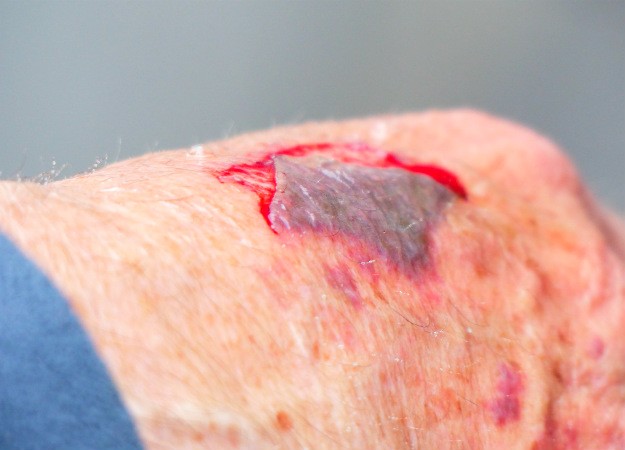Degloving Injury Lawyer
Degloving Injury Lawyer

A degloving injury or avulsion occurs when one or more layers of skin are removed or degloved from the body. Degloving can be life-threatening due to profuse bleeding and tissue death. Degloving injuries can affect any part of the body but it is more common in the face, scalp, torso, arms, and legs.
If you or a family member has suffered a traumatic degloving injury in an accident caused by another party’s negligence, you may be entitled to pursue compensation for your damages. Our experienced injury attorneys can help you file a personal injury claim. Call us for free, friendly advice at (916) 921-6400.
Continue reading to learn more about what degloving means and what treatment options are available.
What You Should Know About a Degloving InjuryIn this article:
- What is a Degloving Injury?
- How Does Degloving Happen
- Severity of Degloving Trauma
- Diagnosis of a Degloving Injury
- Initial Treatment Process of Degloving
- First Surgical Treatment
- Plastic Surgery May Follow
- Possible Complications of a Degloving Injury
- Prognosis of Degloving
A degloving injury derives its name from the type of trauma it describes. Someone who has experienced an avulsion injury has had a significant portion of their skin removed from one or more parts of their body.
For example, someone who has suffered a degloved hand could have one or more layers of skin removed from their hand. This could be the palm, the back of the hand, or even a finger. A serious injury could remove the skin from all of these surfaces.

There are many different ways that someone could potentially suffer a degloving injury. All of them are traumatic in nature and lead to a force that pulls on the skin while leaving the tissue underneath the skin in place. This stretching of the skin over the stationary tissue underneath detaches the skin from its connection with the rest of the body’s tissue. When this connection is severed, the avulsion injury occurs.
- Rock Climbing Degloving – While almost every active sport has the potential to cause an avulsion injury, the risk while rock climbing is particularly high. For example, someone who reaches up for a rock and fails to get a secure grip could have their hand scrape off of the side of the rock. This scraping motion could lead to a finger degloving injury. The risk for a degloved finger is higher if someone gets their wedding ring stuck on a rock while the rest of the hand slips. Furthermore, a rock climber could get their finger or hand stuck in their gear and cause an avulsion injury while pulling their hand to become unstuck.
- Car Accidents – Undoubtedly, auto accidents are another place someone could suffer a degloving injury. A serious accident could throw a driver or passenger from the vehicle, causing an avulsion injury among numerous other traumatic injuries. If someone skids along the pavement at high speed, their skin could get stuck to the pavement as the rest of their body careens along the road. This could lead to degloving injuries in numerous parts of the body. Everyone should make sure to wear their seat belt to prevent being thrown from a vehicle and from suffering this type of extremity trauma.
- Motorcycle Accidents – A motorcycle accident can lead to a degloving injury through similar mechanisms. A rider could think of an avulsion injury as a form of severe “road rash.” When a motorcycle rider has an accident or falls from their motorcycle, they skid along the pavement at high speeds. This causes degloving in a manner similar to that described above. Make sure to wear protection overexposed areas of the skin to guard against this injury.
- Workplace Accidents – People can also suffer a degloving injury while at work. Most injuries that occur in this manner are from people working in heavy industries. Forklifts, augers, and power tools can catch someone’s exposed skin if they aren’t paying attention. Employees could also get a limb stuck in a piece of equipment. This could lead to the limb being fractured, shattered, or degloved in the process. Everyone should make sure that their equipment has been properly maintained. Finally, everyone should take the necessary safety precautions to guard against an injury that could potentially end their career.
There are numerous types of degloving injuries that people should be aware of.
- Abrasion – An abrasion degloving injury is the removal of a patch of skin from a single site. This can be viewed as a superficial avulsion injury; however, this does not mean that it is not serious. While only one plane of skin has been removed, this still has the potential to be a large injury. A large abrasion can lead to severe pain and blood loss. These injuries still warrant the immediate attention of a medical professional to prevent a serious infection from developing.
- Circumferential – In contrast to the abrasion described above, a circumferential injury removes the skin from a limb on all sides. View this injury as someone removing a sock or stocking that used to encase their entire lower leg. Instead of removing an article of clothing, the skin is removed in this fashion. In general, these injuries are more severe than the abrasions described above; however, a circumferential degloving injury can also range in its size and severity. For example, a circumferential degloved finger is going to be different than a circumferential injury of a thigh.
It is also important to note that degloving injuries can be classified based on their depth and the number of layers that have been degloved. A shallow degloving injury may only remove one layer of skin from the surface. On the other hand, more severe injuries could remove multiple layers of skin or even some of the subcutaneous tissue from underneath.
Diagnosis of a Degloving InjuryA degloving injury is typically diagnosed using the clinical picture alone. The doctor will ask the patient a few questions about how and when the injury occurred. They may also ask about the patient’s symptoms, when they developed, and perform a routine physical exam to ensure that other areas of degloving are not missed.
A clinical diagnosis means that lab tests and advanced imaging are not usually required to make the final diagnosis; however, they could still be used to diagnose the severity of the injury and to look for other associated issues.
Depending on the severity of the injury, the first step is clinically stabilizing the patient at a trauma center. Undoubtedly, patients will have lost blood after a degloving injury. A patient will typically receive IV fluids to improve their blood pressure and hydration status. Patients who have lost a significant amount of blood may require a blood transfusion.
Most patients are in severe pain and will receive some sort of pain medication to treat their symptoms. The exposed areas of degloved skin will be wrapped in sterile bandages to stop blood loss and prevent an infection from developing. Some patients may receive antibiotics as a prophylactic measure to guard against developing infections. After this, the patient may be taken to the operating room for treatment.
First Surgical Treatment for a Degloving Injury
While the size of a degloving injury will vary, most patients will require plastic surgery to place a skin covering the area that has been injured. Sometimes, degloved skin is still attached to the rest of the limb. In this case, the skin could be replanted over the surface tissues.
This is an advanced surgical procedure that could also require revascularization of the blood vessels. This will restore the flow of blood to the skin, hopefully keeping it alive.
There is also the possibility that the tissues underneath the degloving injury have been so severely damaged that they cannot be saved. In this case, the patient may require amputation to prevent the dead tissue from damaging the healthy tissue around it.
Plastic Surgery May Follow for Degloving InjuriesWhen a patient has suffered a degloving injury, it can appear extremely gruesome. It is challenging for a surgeon to tell how a skin graft will look immediately after it has been applied. The body needs time to accept the graft and heal the area that has been injured. It could take some time for the patient to truly understand how the graft will look.
There are numerous complications that a patient has to be aware of with any degloving injury.
- Infection – Unfortunately, infection is common with any avulsion injury. The skin is the body’s first and largest barrier to infection. When this has been removed, the body loses this defense against infection. This means that it is much easier for bacteria and viruses to colonize the injured area. Patients can develop severe infections that could require inpatient antibiotics treatment.
- Blood Loss – As with any traumatic injury, the patient could lose a significant amount of blood. Patients who have lost a large amount of blood could have their blood pressure drop, their heart rate rise, and could pass out. Physicians will treat blood loss with IV fluids and, potentially, a blood transfusion. Severe degloving injuries could lead to life-threatening amounts of blood loss that require emergent treatment.
- Psychological Trauma – Some patients will suffer from some forms of depression following the injury. Due to their appearance and slow return to baseline functioning, patients may feel a lack of confidence that makes it difficult to carry out daily activities. Patients should focus on their rehabilitation, which might be required to restore function, and ask for the support of their family and friends during a challenging time.
The patient’s prognosis must be taken on a case-to-case basis because these injuries can range in severity. If the injury is small and superficial, the patient could be left with only a scar.
A severe injury could damage the tissues underneath and limit the motor and sensory function of the limb. The most severe degloving injuries could result in an amputation of the limb itself. Because of the wide spectrum, patients should speak with their physician about the prognosis of their individual case.
Watch the video from Audiopedia to know more about degloving injury:
Contact a Sacramento Degloving Injury Attorney TodayI’m Ed Smith, a Sacramento Degloving Injury Lawyer. Suffering from or seeing a loved one suffer from a degloving injury is one of the most difficult situations you’ll experience in your life. Because this is a high-risk injury, urgent medical treatment is always a must to help the patient recover faster. But, to avoid this from happening to you or a loved one, extra care should be observed at all times.
If you have suffered a degloving injury in an accident, please call me at (916) 921-6400 or (800) 404-5400 for free, friendly advice.
Proud members of the Million Dollar Advocates Forum and the National Association of Distinguished Counsel.
See our client reviews on Google, Yelp, and Avvo and case history of verdicts and settlements.
Editor’s Note: This article has been updated for accuracy and relevancy [cha 3.16.21]